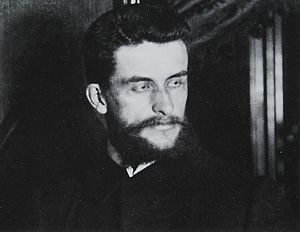Waldemar Titzenthaler facts for kids
Waldemar Franz Hermann Titzenthaler (born August 19, 1869 – died March 7, 1937) was a German photographer. He was known for his amazing photos of cities, buildings, and people. His work helps us see what life was like in the past.
Life of a Photographer
Waldemar Titzenthaler was born in Ljubljana, which was then part of Austria. His father was also a photographer for a royal family. Waldemar learned photography from 1886 to 1889. He trained with Karl Friedrich Wunder in Hanover.
After his training, he worked in several cities. These included Oldenburg, Hanover, and Leipzig. In 1896, he moved to Berlin. There, he joined a company called Zander & Labisch. He often took pictures for a newspaper called Berliner Illustrirte Zeitung.
In 1897, Waldemar opened his own photo studio. He quickly became one of Germany's first commercial photographers. This means he took pictures for businesses and advertisements. Many big companies in Berlin hired him.
From 1901, he was part of photography groups. He even led the Photographischer Verein zu Berlin from 1907 to 1911. This group later made him an honorary master. From 1910, he worked for courts. He also helped the Berlin Chamber of Commerce as an expert on photography.
Between 1912 and 1931, Titzenthaler worked for Die Dame magazine. This magazine was published by Ullstein Verlag. For them, he photographed the homes of famous actors, singers, and architects. From 1934, he lived in Berlin Lichterfelde.
Waldemar Titzenthaler was also involved with a mountain climbing club. He led the Berlin section of the German and Austrian Alpine Club. He held strong nationalistic views. Because of these views, a mountain path named after him was later renamed. In 2003, the path to the Hochjoch-Hospiz was changed to the Cyprian Granbichler Memorial Path. A memorial plaque for him was also changed over time due to his past views.
Titzenthaler passed away in 1937 at the age of 67.
Titzenthaler's Photo Collection
Waldemar Titzenthaler's wife saved some of his photo collection during World War II. In the early 1950s, the Berlin State Archives bought these old photos. These pictures were taken between 1896 and 1920. They are now kept safe there.
You can also see some of his photographs at the Oven and Ceramics Museum Velten. Many of his pictures show Berlin in the late 1800s and early 1900s. His photos were taken with great care and skill. They are very important records of the past.
Photo Exhibitions
Titzenthaler's work has been shown in several exhibitions:
- Photographs by Waldemar Titzenthaler: On the Road in Germany and Europe
* This exhibition was held from October 17, 2008, to February 27, 2009. * It was shown at the Landesarchiv Berlin.
- Titzenthaler – Four Photographers, Three Generations – 100 Years of Photography
* This show ran from June 29 to September 21, 2008. * It was at the Landesmuseum für Kunst und Kulturgeschichte Oldenburg.
- Sisterhood Years 1875 to Today
* This exhibition was by the DRK-Schwesternschaft Berlin. * It featured Titzenthaler's photos of nurses and World War I veterans.






